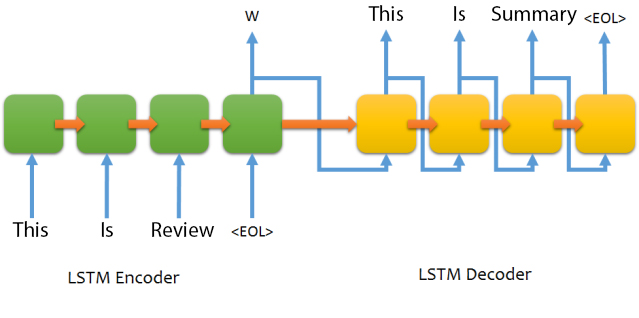Uses Recurrent Neural Network (LSTM and GRU units) for developing Seq2Seq Encoder Decoded model with and without attention mechanism for summarization of amazon food reviews into abstractive tips.
- DataSet Information - This dataset consists of reviews of fine foods from amazon. The data span a period of more than 10 years, including all ~500,000 reviews up to October 2012. Reviews include product and user information, ratings, and a plaintext review.
The dataset can be downloaded from here
A sample dataset example looks like this -
product/productId: B001E4KFG0
review/userId: A3SGXH7AUHU8GW
review/profileName: delmartian
review/helpfulness: 1/1
review/score: 5.0
review/time: 1303862400
review/summary: Good Quality Dog Food
review/text: I have bought several of the Vitality canned dog food products and have
found them all to be of good quality. The product looks more like a stew than a
processed meat and it smells better. My Labrador is finicky and she appreciates this
product better than most.
The input review has key review/text and the target summary that we wish to generate has key review/summary. For the purpose of this project, all other fields are ignored and the following two fields are extracted by the extracter script provided.
- Create a barebone virtual environment and activate it
virtualenv deepsum --no-site-packages
source deepsum/bin/activate
- Install the project requirements
pip install -r requirements.txt
- Extract the reviews and target tips using the following command
python extracter_script.py raw_data/finefoods.txt extracted_data/review_summary.csv
NOTE: Don't forget extracting the dataset and keeping it in the raw_data directory before running the above command.
- Then run the seed script to create the required permuted training and testing dataset and also train and evaluate the model
# Simple - No Attention
python train_scripts/train_script_gru_simple_no_attn.py
This runs the Simple GRU Cell Based (Without Attention Mechanism) Encoder Decoder model.
- Once the above script has completed execution run one of the following scripts in whichever order desired.
- For Models without Attention Mechanism
# Simple - No Attention
python train_scripts/train_script_lstm_simple_no_attn.py
# Stacked Simple - No Attention
python train_scripts/train_script_gru_stacked_simple_no_attn.py
python train_scripts/train_script_lstm_stacked_simple_no_attention.py
# Bidirectional - No Attention
python train_scripts/train_script_gru_bidirectional_no_attn.py
python train_scripts/train_script_lstm_bidirectional_no_attn.py
# Stacked Bidirectional - No Attention
python train_scripts/train_script_gru_stacked_bidirectional_no_attn.py
python train_scripts/train_script_lstm_stacked_bidirectional_no_attention.py
- For Models with Attention Mechanism
# Simple - Attention
python train_scripts/train_script_gru_simple_attn.py
python train_scripts/train_script_lstm_simple_attn.py
# Stacked Simple - Attention
python train_scripts/train_script_gru_stacked_simple_attn.py
python train_scripts/train_script_lstm_stacked_simple_attention.py
# Bidirectional - Attention
python train_scripts/train_script_gru_bidirectional_attn.py
python train_scripts/train_script_lstm_bidirectional_attn.py
# Stacked Bidirectional - Attention
python train_scripts/train_script_gru_stacked_bidirectional_attn.py
python train_scripts/train_script_lstm_stacked_bidirectional_attention.py
- Finally exit the virtual environment once you have completed the project. You can reactivate the env later.
deactivate
